Dogs are always communicating, and they don’t speak our language. They speak dog. Dogs communicate with us through body language and energy. They have very elaborate ways of expressing how they’re feeling and can tell us when they’re angry, afraid, anxious, curious, happy and much more, by using every part of their body to convey their emotional state of being. Reading dog body language can be confusing because it’s a very sophisticated and complex system of nonverbal communication, but thankfully we can learn how to read and understand what they’re trying so hard to tell us.
Let’s find out if you can “hear” what these dogs are trying to say.
1. Look away: discomfort
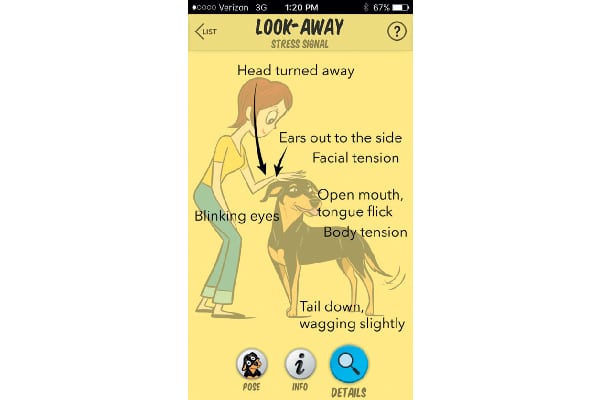
A dog looking away signals discomfort in dog body language. Dog Decoder smartphone app | Illustration by Lili Chin.
Look at the image above. You may think that this is a sweet exchange. Look again. When a dog looks away, they are signaling that they are uncomfortable with what’s happening. Notice in the image from the Dog Decoder app, showing you the body parts that are talking. These are all signs of discomfort in dog body language.
2. Facial expressions: stress
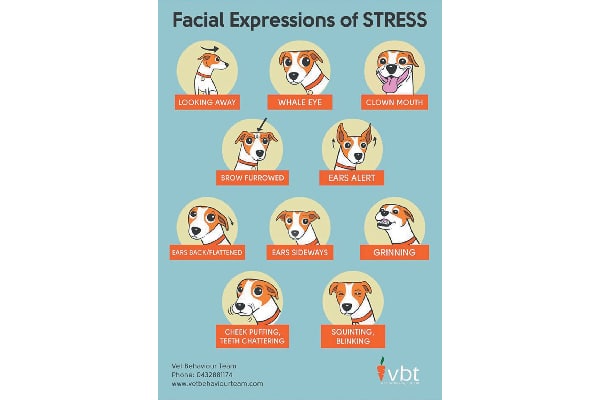
These facial expressions spell out stress in dog body language. Vet Behavior Team l Illustration by Lili Chin.
Dogs use their ears, eyes, tail, body posture, body orientation, facial tension and body tension in various ways, signaling their intentions and feelings to other dogs and to us.
In order to understand dog body language, look at the entire body, not just one part. For example, a wagging tail doesn’t necessarily mean a happy dog. If the tail is straight up, stiff and wagging fast and short, this is most likely a dog who feels threatened and may bite. A low horizontal tail wag is one of appeasement, while a lively horizontal tail is one of joy. A tucked tail is an expression of fear. In this way, we can put all the parts together to determine what a dog is telling us. Context is as important as reading all the body parts talking. When you look at the parts talking you must also look at what’s happening while the dog is expressing herself.
3. Body talk: warning
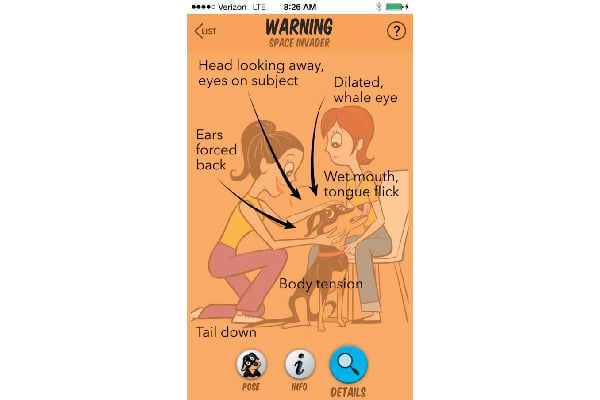
There are many warning signs in dog body language. Dog Decoder smartphone app | Illustration by Lili Chin.
In the image above, you’ll see a lot of body parts talking. They happen so fast, if you don’t know how to read them you may miss them. This image was drawn from a real-life situation.

This dog is giving off warning signs of fear and stress. Photography © cynoclub | Getty Images.
Kyle Dyer, a news anchor in Denver, Colorado, was doing a Good Samaritan show about a firefighter rescuing a dog from a frozen pond. The dog was rescued only the day before and was still traumatized. Add to this the trauma of being in a TV studio with strangers petting him and lights blaring, and you have a dog who is over his threshold of tolerance, and now he’s on camera in between his owner’s legs while Kyle Dyer is petting him, having no idea that the dog was not liking it one bit and about to bite. She was bitten in the face, taking part of her lip off, just a few seconds after the dog looked away. She had to run off the set and was taken to the hospital.
4. Subtle signs: scratch, blink
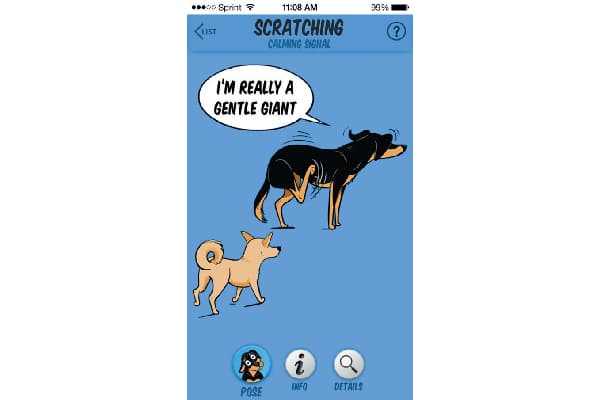
A dog scratching is a displacement behavior. Dog Decoder smartphone app | Illustration by Lili Chin.
Some other subtle signs to be aware of in dog body language — scratching, blinking in appeasement and many more. Some of these communications are what are called displacement behaviors, like scratching in the image above. The bigger dog doesn’t have an itch, he’s telling the little dog that he’s friendly, by looking away and scratching, showing no signs of pressure.
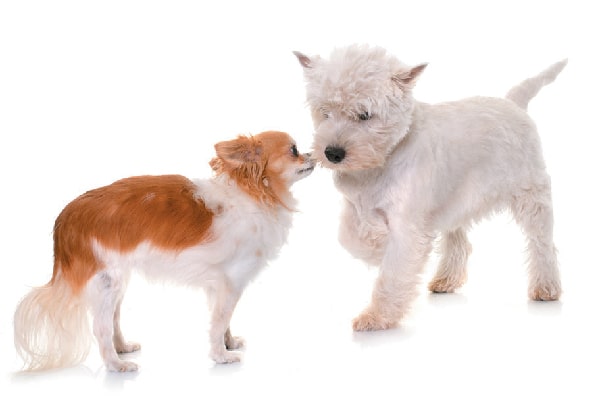
The paw lift, lightly raised tail and ears out to the side are subtle signs of a cautious greeting. Photography © cynoclub | Getty Images.
5. Signs of joy in dog body language
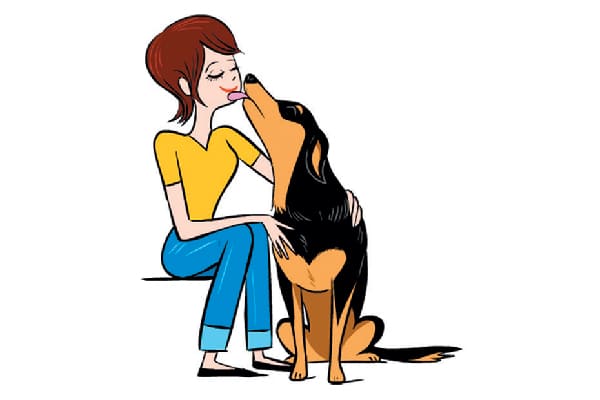
A dog licking a human is a sign of joy. Dog Decoder smartphone app | Illustration by Lili Chin.
Dogs also convey signs of joy or appeasement, as shown in the image at left, which are easy for us to recognize. If you want the deepest, most profound bond with your dog, learning to speak her language is the best thing you can do for your relationship.
If you can imagine all the ways dogs talk and how fast these signs can be, you’ll realize how it’s easy to miss some of the more subtle cues, giving way to some pretty big misunderstandings between humans and dogs. When we misunderstand dogs, we may be asking something of a dog who is telling us she’s very confused, which looks to us like refusal when, in fact, it’s confusion. Responding as if the dog is being disobedient instead of confused, we may get upset with her rather than realizing she needs our help to better understand what we are asking for.
Each time we misunderstand our dogs, we are breaking down the very fabric of our relationship, destroying the thing we want most — a healthy, respectful and reciprocal bond.
The Dog Decoder App

Learn to read your dog’s body language with the Dog Decoder app. Photography ©GlobalP | Getty Images.
Dog trainer Jill Breitner created this app to engage, teach and help people to be their dog’s best advocate. You’ll find about 60 dog body poses with diagrams deciphering what’s really going on and how the dog is feeling. Find out common misconceptions plus situations that cause your dog to assume that posture. Available in Google Play and iTunes.
Thumbnail: Photography © cynoclub | Getty Images.
Award-winning writer Jill Breitner has been training dogs since 1978. Her passion lies in teaching people about dog body language. Jill created the Dog Decoder app as a way to enhance the human-dog bond by understanding them better. You’ll find her at play near the ocean. Follow her at dogdecoder.com, facebook.com/dogdecoder and on Twitter @shewhispers.
Editor’s note: This article first appeared in Dogster magazine. Have you seen the new Dogster print magazine in stores? Or in the waiting room of your vet’s office? Subscribe now to get Dogster magazine delivered straight to you!
Read more about understanding dogs on Dogster.com:
- 4 Dog Sounds and What They Mean
- Whale Eyes in Dogs — What It Means When the Whites of Your Dog’s Eyes Show
- How Do Dogs Show Affection to Humans?
The post 5 Keys to Understanding Dog Body Language appeared first on Dogster.
No comments:
Post a Comment